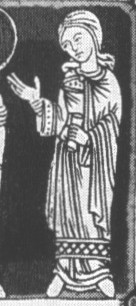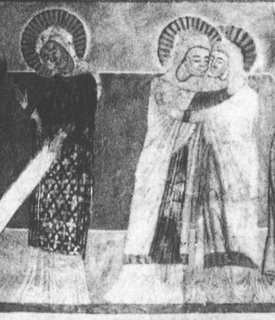It's been over 2 years since I last made a dress! An overgarment finished just in time for the second Yass festival. I've made a couple of chemise, a cloak, hose and sundry accessories, but no new garments. It's time for things to change in a big way. There are several garment's I've been mulling over for quite a while. One of them is a German style 12th Century garment. I've got a medium length of fabric that I won in a competition.
It's been over 2 years since I last made a dress! An overgarment finished just in time for the second Yass festival. I've made a couple of chemise, a cloak, hose and sundry accessories, but no new garments. It's time for things to change in a big way. There are several garment's I've been mulling over for quite a while. One of them is a German style 12th Century garment. I've got a medium length of fabric that I won in a competition. Purple Cotton with yellow small flowerlike motifs woven in a repeating fashion. It's not perfect, but it is better than most of the fabrics I can find in the upholstery fabric section and I didn't pay for it. (I don't feel it would have been that expensive that it should be saved for good, just a lucky pattern find) The patterned nature of the fabric, and it's stiffness make it ideal for this project, as does it's shorter length - I'll be lucky to get a dress out of this short a length even with the shorter hemline of this style. If this works well I am eyeing off some pretty ecclesiastical brocades, but I always have trouble spending more than $6/m on fabric.
Well, anyway, a couple of others have beaten me to making this style, but I want to look further into the style before I cut out (despite this project mulling in my head for 2 years). So I'll start commenting on pictures here.
Starting with pictures from my favourite artbook - C.R. Dodwell "Pictorial Arts of the West" (if anyone would like to buy me a hardcover copy, you'll be my friend forever!)



1. Eilibert of Colonge, top of a portable altar c1160, Berlin Stadtliche Museum
- Presumably Eilibert resided in Colonge (or Köln) on the german/france border and copied local dress styles. I hope.
- several women depicted, so a variety of styles. Can make two big divisions. The saints are dressed piously - full length dresses, lots of mantle wrapped around, veil looser around the neck. (not depicted).Youngg women with shorter outer layer, hardly any wraps or mantles, more decoration and more exciting headwear. From posture and comparison to other works, I think these might be virtues.
- check out the hat in the last picture. I'm not sure if that's a veil or loose hair under it.

2.Bjäresjö (Scania) church choir vault, 1st half of the 13th C
- Scania (Skåne) is in SW sweden apparently (it was part of Denmark in the 12th C though). Dodwell has a nice map of all the (often obscure) places he mentions- It's right on the southern tip. Scania includes Lund too apparently. I learn something new every day.
- I guess Dodwell knows his datings (I respect him a lot), but I wouldn't have guessed the fashion lasted as late as the 13th C. This looks more like first half 12th C fashions to me.
- Note how white the layer that touches the ground is - I think this argues for chemise, not underdress.
- It's a saint, with typical saintly veil and mantle, but still she wears the shorter garment and patterned fabric. Looks like it was a fashion with more than just young unmarried women.

3. Helmarshausen "Presentation at the temple" Psalter of Henry the Lion, MS Lansdowne 381 fol 8, 1168/89 (British Library)
- Helmarshauen is now a suburb of Bad Karlsruhe in central Germany (Hessen)
- Apparently the vertically elongated figures are to be expected due to the influence of the english Matilde, who became empress
- This figure is standing around looking decorative/offering blessings. I bet she's annother virtue equivalent. The pair of doves are probably for luck (not necessarily literally there) and I'm sure whatevershe is holding has some significance too.

4.Helmarshausen. "The spiritual coronation of Henry the Lion and Matilde", Gospels of Henry the Lion from Brunswich, MS Guelph 105 Noviss 2°, folio 171v, c1188 (Herzog August Bibliothek, Wolfenbüttel)
- Same style notes as previous entry
- Dodwell's text implies this figure should be Matilde's grandmother. If not her, a family member at least. A real person, not a virtue!
- It's tricky to see, but you can just see the white chemise peaking out from behind the border frame at the bottom left corner.


5. Helmarshausen. "The crucifixtion" A Gospels MS 142, f90v, c1190-1200 (Dombibliothek, Trier)
- Same artistic notes apply to first half (which this is in) of this manuscript as before.
- I think the figure may actually be male, but I'm not sure. The second figure almost certainly is. Other figures presentraditionallyionaly dressed women with floor length skirts. Note how the first figure has a chemise/shirt that is just that bit longer than the second - that's what makes me wonder atgendereneder, despite the short sleevehairstyleirstle that is more likely to be male than female.
Well that's enough for today. I think I'll keep most of the conclusions until I've posted more photos. Just one conclusion:
Matilde's grandmother is shown in a garment that is patterned and highly decorated, and above floor length, so this is not just a style worn by literary examples, it is depicted as worn by real people.

No comments:
Post a Comment